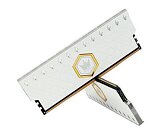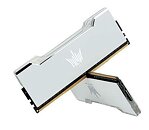- Joined
- Oct 9, 2007
- Messages
- 47,675 (7.43/day)
- Location
- Dublin, Ireland
| System Name | RBMK-1000 |
|---|---|
| Processor | AMD Ryzen 7 5700G |
| Motherboard | Gigabyte B550 AORUS Elite V2 |
| Cooling | DeepCool Gammax L240 V2 |
| Memory | 2x 16GB DDR4-3200 |
| Video Card(s) | Galax RTX 4070 Ti EX |
| Storage | Samsung 990 1TB |
| Display(s) | BenQ 1440p 60 Hz 27-inch |
| Case | Corsair Carbide 100R |
| Audio Device(s) | ASUS SupremeFX S1220A |
| Power Supply | Cooler Master MWE Gold 650W |
| Mouse | ASUS ROG Strix Impact |
| Keyboard | Gamdias Hermes E2 |
| Software | Windows 11 Pro |
GALAX on Thursday introduced the Hall of Fame (HOF) OC Lab Diamond and HOF OC Lab Phantom lines of enthusiast-segment memory. These kits are led by a DDR4-5000 memory kit with 19-26-26-46 timings. The company didn't put out voltages, but the DDR4-4800 + 19-22-22-46T variant in the same series pulls 1.5 V, so the DDR4-5000 kit is only expected to be equal or higher. Other high-voltage hits include DDR4-4600 18-26-26-42 @1.5 V; DDR4-4400 18-22-22-42 @1.50 V; and DDR4-4266 17-22-22-38 @1.50 V. The HOF OC Lab Diamond memory kits feature chunky aluminium heatspreaders with pearl-white finish and a gold-plated ornament.
The HOF OC Lab Phantom line is positioned a notch below the HOF OC Lab Diamond. It comes in enthusiast-segment memory frequencies of DDR4-4000 17-19-19-38 @1.45 V (19-25-25-25 @1.40 V); DDR4-3866 16-18-18-36 @1.40 V, and DDR4-3600 16-16-16-36 @1.35 V. These modules feature aluminium heatspreaders with an acrylic crown RGB diffuser. The aluminium heatspreader features diamond-cut edges. The company didn't reveal pricing of either kits. At this time only the Greater China regional division of GALAX released the two memory lines.


View at TechPowerUp Main Site
The HOF OC Lab Phantom line is positioned a notch below the HOF OC Lab Diamond. It comes in enthusiast-segment memory frequencies of DDR4-4000 17-19-19-38 @1.45 V (19-25-25-25 @1.40 V); DDR4-3866 16-18-18-36 @1.40 V, and DDR4-3600 16-16-16-36 @1.35 V. These modules feature aluminium heatspreaders with an acrylic crown RGB diffuser. The aluminium heatspreader features diamond-cut edges. The company didn't reveal pricing of either kits. At this time only the Greater China regional division of GALAX released the two memory lines.


View at TechPowerUp Main Site



